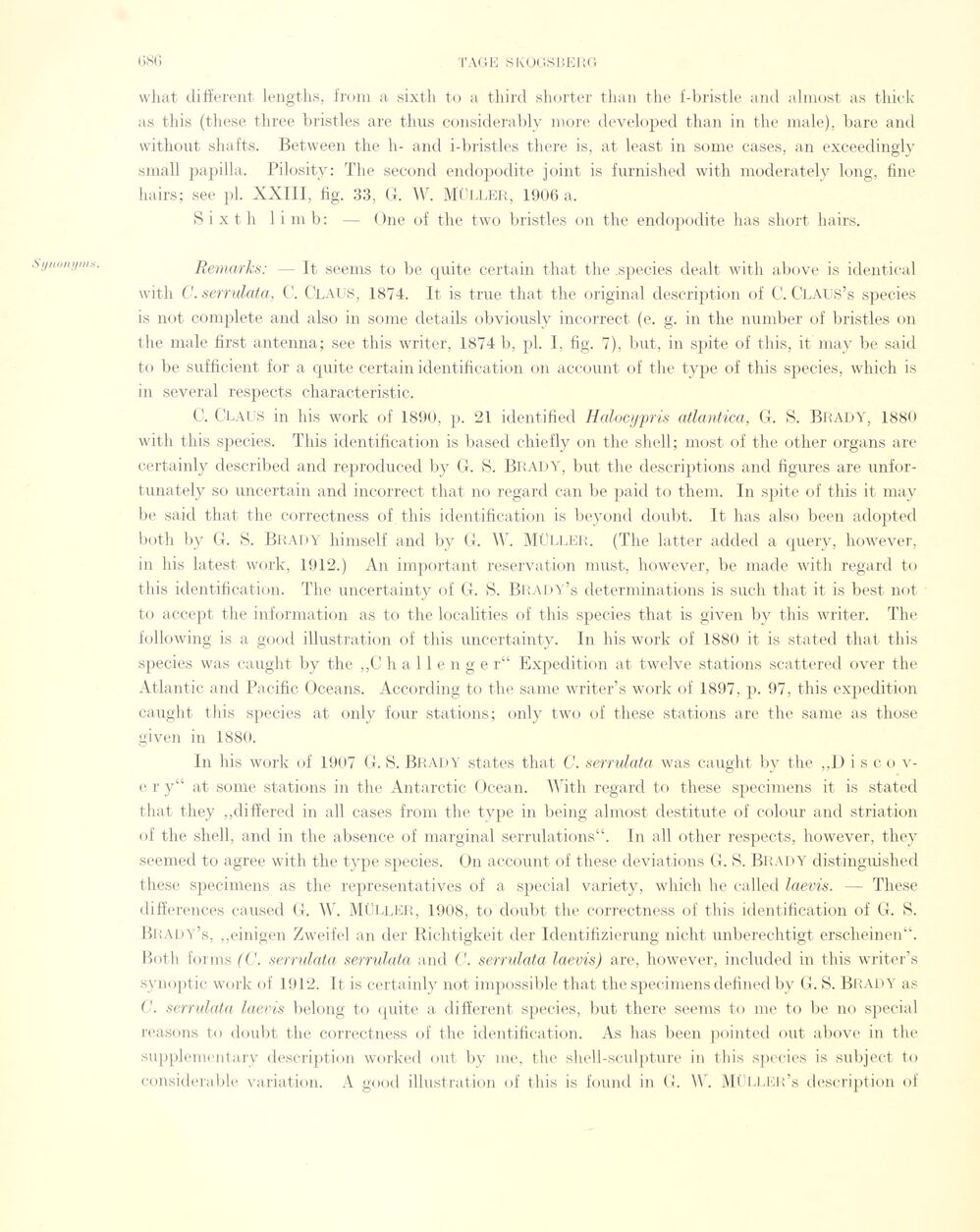
Full resolution (JPEG) - On this page / på denna sida - Sidor ...

<< prev. page << föreg. sida << >> nästa sida >> next page >>
Below is the raw OCR text
from the above scanned image.
Do you see an error? Proofread the page now!
Här nedan syns maskintolkade texten från faksimilbilden ovan.
Ser du något fel? Korrekturläs sidan nu!
This page has never been proofread. / Denna sida har aldrig korrekturlästs.
what di fierent lengths, from a sixth to a third shorter than the f-bristle and almost as thick
as this (these three bristles are thus considerably more developed than in the male), bare and
without shafts. Between the h- and i-bristles there is, at least in some cases, an exceedingly
small papilla. Pilosity: The second endopodite joint is furnished with moderately long, fine
hairs; see pi. XXIII, fig. 33, G. W. MÜLLER, 1906 a.
Sixth 1 i m b : — One of the two bristles on the endopodite has short hairs.
Remarks: — It seems to be quite certain that the species dealt with above is identical
with C. serrulata, C. Claus, 1874. It is true that the original description of C. CLAUS’s species
is not complete and also in some details obviously incorrect (e. g. in the number of bristles on
the male first antenna; see this writer, 1874 b, pi. I, fig. 7), but, in spite of this, it may be said
to be sufficient for a quite certain identification on account of the type of this species, which is
in several respects characteristic.
C. Claus in his work of 1890, p. 21 identified Halocypris atlantica, G. S. BRADY, 1880
with this species. This identification is based chiefly on the shell; most of the other organs are
certainly described and reproduced by G. S. BRADY, but the descriptions and figures are
unfor-tunately so uncertain and incorrect that no regard can be paie! to them. In spite of this it may
be said that the correctness of this identification is beyond doubt. It has also been adopted
both by G. S. BRADY himself and by G. W. MÜLLER. (The latter added a query, however,
in his latest work, 1912.) An important reservation must, however, be made with regard to
this identification. The uncertainty of G. S. Brady’s determinations is such that it is best not
to accept the information as to the localities of this species that is given by this writer. The
following is a good illustration of this uncertainty. In his work of 1880 it is stated that this
species was caught by the „C h a 11 e n g e r“ Expedition at twelve stations scattered over the
Atlantic and Pacific Oceans. According to the same writer’s work of 1897, p. 97, this expedition
caught this species at only four stations; only two of these stations are the same as those
given in 1880.
In his work of 1907 G. S. BRADY states that C. serrulata was caught by the ,,I) i s c o
v-e r y“ at some stations in the Antarctic Ocean. With regard to these specimens it is stated
that they „differed in all cases from the type in being almost destitute of colour and striation
of the shell, and in the absence of marginal serrulations“. In all other respects, however, they
seemed to agree with the type species. On account of these deviations G. S. BRADY distinguished
these specimens as the representatives of a special variety, which lie called laevis. — These
differences caused G. W. Müller, 1908, to doubt the correctness of this identification of G. S.
Brady’s, „einigen Zweifel an der Richtigkeit der Identifizierung nicht unberechtigt erscheinen“.
Both forms (C. serrulata. serrulata and C. serrulata laevis) are, however, included in this writer’s
synoptic work of 1912. It is certainly not impossible that the specimens defined by G. S. Brady as
C. serrulata laevis belong to quite a different species, but there seems to me to be no special
reasons to doubt the correctness of the identification. As has been pointed out above in the
supplementary description worked out by me, the shell-sculpture in this species is subject to
considérable variation. A good illustration of this is found in G. W. MüLLER’s description of
<< prev. page << föreg. sida << >> nästa sida >> next page >>